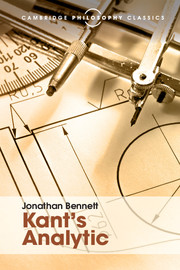2 - The outer-sense theory
from Aesthetic
Published online by Cambridge University Press: 05 July 2016
Summary
The form of outer sense
Kant uses the word ‘sensibility’ for one's capacity for being in any sort of sensory state. He says that this capacity is exercised in two ways: as outer sense, it permits one to have sensory states which are seeings, hearings, feelings etc. of things other than oneself; as inner sense, it permits one to have sensory states which may relate to one's environment but may be just states of oneself. Thus, all sensory states are mediated by inner sense, and some by outer sense as well: notwithstanding one queer remark suggesting the contrary, the proper contrast is not between ‘outer’ and ‘inner’ but between ‘outer (and also inner)’ and ‘only inner’. As Kant says:
Whatever the origin of our [sensory states], whether they are due to the influence of outer things, or are produced through inner causes,…they must all, as modifications of the mind, belong to inner sense.
Our present concern is with outer sense.
In all the variety of my sensory awareness of the world there is, according to Kant, the constant factor that every one of these states of awareness is the end-product of a transaction between my sensibility and some part of the world outside me. Wherever and whenever it occurs, whatever fragment of the varied world it confronts me with, any ‘outer’ sensory state is given to me by my sensibility in its function as outer sense. This suggests that there might be some features which characterize all my experiences of the world, not because of any uniformity in the world but rather because my outer sense imposes these features upon its entire output. Kant says that this is indeed the case. Specifically, the outer sense of every human is such as to guarantee that the outer world which he experiences will always conform to the theorems of Euclidean geometry—these being construed, we must add, synthetically. Regarding the geometrical experiment described in the preceding section, Kant would presumably say that, although such a sequence of observations can be described without logical inconsistency, its occurrence is ruled out by the modus operandi of the human outer sense.
- Type
- Chapter
- Information
- Kant's Analytic , pp. 16 - 34Publisher: Cambridge University PressPrint publication year: 2016



